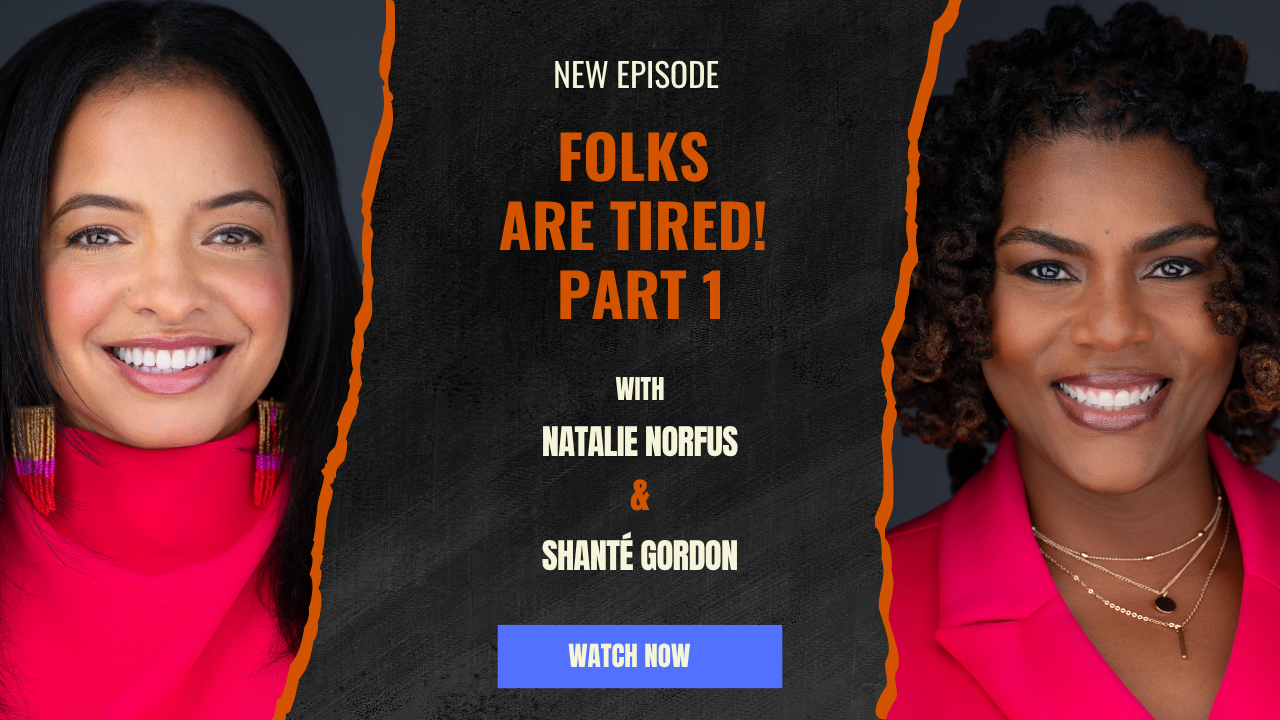Folks Are Tired! Part 1

Let’s be honest: burnout is not a buzzword—it’s a reality for more people than we care to admit. And while “quiet quitting” dominated headlines in recent years, the conversation has often missed the mark. What we’re really seeing is a reckoning: people are tired, they’re disconnected, and they’re done overperforming for underwhelming returns.
In the first installment of our three-part podcast series on burnout, we break down the true nature of burnout, the emotional and professional toll it takes, and why it disproportionately impacts historically excluded groups in the workplace. Whether you’re a DEI leader, HR strategist, or manager trying to lead through it, understanding the layers beneath employee fatigue is no longer optional—it’s essential.
The Anatomy of Burnout: It’s More Than Just Exhaustion
Burnout isn’t simply being tired or needing a long weekend. It’s a triad of depletion:
-
Energetic Exhaustion – The physical and mental fatigue that doesn’t go away, even with rest. You wake up tired. You log off tired. There’s no refill.
-
Disconnection – A cynical, sometimes hostile detachment from your work, your coworkers, and your organization. You stop caring, not because you’re unprofessional—but because you’ve hit your limit.
-
Performance Breakdown – Your output suffers. Deadlines slip. Focus fades. You’re doing the job, but not really doing the job.
And at the core? The misalignment between the effort you’re putting in and the reward you’re getting back, whether that’s recognition, compensation, purpose, or growth. The math just isn’t mathing anymore.
Burnout vs. Quiet Quitting: Why the Words Matter Less Than the Truth
Let’s clear something up: quiet quitting is not quitting at all. It’s employees doing what their job description requires—nothing more, nothing less. No extra Slack messages at 10 PM. No last-minute project heroics. Just… work. And for some reason, that’s been painted as rebellion.
But here’s the real issue: when people—especially Black and Brown professionals, LGBTQ+ folks, and others on the margins—decide to honor their boundaries, it gets labeled as disengagement. For others, it’s called balance.
As Shanté shared on the podcast, many of us were raised with the message: You have to work twice as hard to get half the credit. So we internalize that. We overdeliver. We outperform. And when the reward doesn’t follow? When the promised promotion is delayed (again)? When leadership shrugs
The DEI Lens: Burnout Hits Some People Harder
The pandemic didn’t just change how we work—it revealed what was already broken. Studies from McKinsey, Deloitte, and others have shown that historically excluded groups experienced more health crises, more job losses, and more emotional labor during the height of COVID-19. Add the racial reckoning of 2020 and the ongoing wave of political and cultural shifts, and you have a workforce segment that is running on fumes.
Here’s what that looks like:
-
BIPOC employees getting passed over despite stellar performance.
-
LGBTQ+ workers managing microaggressions while still delivering high-impact work.
-
Women of color bearing the invisible weight of “culture keeping” without compensation.
So when we talk about burnout, let’s not generalize it. For many, burnout isn’t just about being tired. It’s about being worn down by inequity.
Leaders, This One’s on You
If you’re leading a team, department, or organization, you may not feel equipped to “fix” burnout. That’s fair. But ignoring it? That’s not an option.
Start here:
-
Observe Behavior Shifts: Is your star performer suddenly withdrawn? Is your team missing deadlines? Are there more interpersonal conflicts or complaints?
-
Listen Beyond the Surface: If someone says they’re “fine” but their energy is off, ask again. Provide space. Make it safe.
-
Question the Systems: Are your promotion paths clear? Is feedback culturally aware? Are you rewarding performance fairly?
As Natalie said during the episode, burnout complaints often aren’t about the work. They’re about being unseen, unheard, and undervalued. If your team is burning out silently, it will cost you—whether it’s through attrition, low morale, or reputational damage.
The Privilege of “Quiet Quitting”
Let’s not gloss over the fact that the ability to set boundaries and still remain in good standing is a privilege. Some employees are judged just for doing their jobs as assigned—no extras. For others, setting limits is praised as “knowing your worth.”
When leaders and organizations talk about “quiet quitting,” they must also acknowledge the privilege gaps:
-
Who gets to do less and still be considered high potential?
-
Who must overperform just to be seen as competent?
-
Who faces repercussions for speaking up—or for simply disengaging?
If you’re not interrogating these disparities, you’re not really leading inclusively.
So, What Can We Do?
Here’s what we suggest if you want to shift the culture of burnout in your organization without swinging the pendulum into paternalism:
-
Redefine Productivity
Not everything valuable can be measured by deliverables. Relationship building, mentorship, psychological safety—all of that matters. Start factoring it in.
-
Build Flexible Pathways to Success
Some people want to climb. Others want consistency. Make room for both. Don’t penalize someone for choosing balance.
-
Invest in DEI-Focused Wellness
Not just yoga Zooms. Offer wellness benefits that consider cultural context. Include mental health stipends, therapy options with diverse providers, and actual time off.
-
Equip Managers to Spot Burnout
Train people leaders to notice burnout early. Give them scripts to talk about it and permission to adapt workloads when needed.
-
Keep Listening
The employees who are most affected often know exactly what’s broken. The question is: are you creating real opportunities to hear them?
The Bottom Line: Burnout is a DEI Issue
This isn’t just about resilience. It’s about representation, fairness, and sustainability. You can’t solve burnout without looking at the systems that uphold it. And you can’t talk about engagement without addressing the equity gaps that drain people in the first place.
As we move deeper into this series, we’ll tackle:
-
The leader’s personal responsibility to model sustainable work
-
What organizations are actually accountable for (and where the line is)
Until then, we leave you with this: if you keep running full speed without checking the people behind you, you may just end up like Will Ferrell in Old School—streaking down the road, hyped up… and completely alone.
Let’s do better. Let’s lead better.
Connect With Us
If you found this discussion compelling, we invite you to connect with us further. Here are some ways to stay in touch:
- Follow Natalie Norfus on LinkedIn
- Follow Shanté Gordon on LinkedIn
- Book a consultation with The Norfus Firm
- Follow What’s the DEIL on Instagram and TikTok
